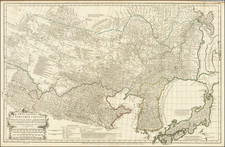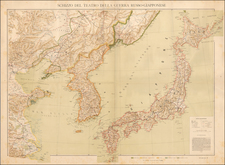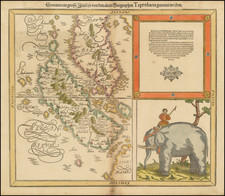Stunning Original Hand-Color.
Rare English sea chart of the South China Sea, published in London by Robert Sayer for an early edition of his The Oriental pilot, or, A select collection of charts and plans ... for the navigation of the country trade in the seas beyond the Cape of Good Hope..
The map stretches from Taiwan and Canton in the north to Luzon in the east and Singapore in the southwest. Sayer includes dozens of soundings throughout the coverage of the chart.
Sayer's Oriental Pilots and their successor books were rare, prized things in their day; they were specially made, cutting-edge tools used exclusively by those actually sailing to the east. The books remain rare today, with later editions typically selling for around $100,000 or more. We cannot trace an early edition of the book, such as the edition that this map would have been included in.
In Laurie & Whittle East India Pilots, the present chart would be replaced with this one: https://www.raremaps.com/gallery/detail/36599
The chart was largely based on a map by d'Après de Mannevillette (dedicated to Alexander Dalrymple) which was titled A Chart of the China Sea...
Captain Hayter named in the title was evidently Captain George Hayter of the East India Company Ship York. The York was in Chinese waters frequently between 1741 and 1786. Hayter's name is on other contemporary charts of the area, such as "A Chart of the China Sea from the Island of Sancian to Pedra Branca... from a Portuguese draught communicated by Captain Hayter..."
Rarity
No similarly-colored copy of the map has been on the market since Susanna Fisher's 1988 Charts 56 catalog - this is the same example that was offered there.
Robert Sayer (ca. 1724-1794) was a prominent London map publisher. Robert’s father was a lawyer, but his older brother married Mary Overton, the widow of prominent mapmaker Philip Overton and the proprietor of his shop after his death. Mary continued the business for roughly a year after her marriage and then, in early 1748, it passed to Robert. Robert became a freeman of the Stationers’ Company later that year; his first advertisement as an independent publisher was released in December.
Sayer benefited from Overton’s considerable stock, which included the plates of John Senex. In the 1750s, Sayer specialized in design books and topographical prints, as well as comic mezzotints. In 1753, he, along with John Roque, published a new edition of Thomas Read’s Small British Atlas, the first of several county atlases that Sayer would publish.
Sayer’s business continued to grow. In 1760 he moved further down Fleet Street to larger premises at 53 Fleet Street. In 1766, he acquired Thomas Jefferys’ stock when the latter went bankrupt. In 1774, he entered into a partnership with John Bennett, his former apprentice. The pair specialized in American atlases, based on the work of Jefferys. They also began publishing navigational charts in the 1780s and quickly became the largest supplier of British charts in the trade.
Bennett’s mental health declined, and the partnership ended in 1784. As Sayer aged, he relied on his employees Robert Laurie and James Whittle, who eventually succeeded him. He spent more and more time at his house in Richmond. In 1794, he died in Bath.












![[Singapore Strait] A Plan of the Soundings from Pulo Aor to the Southward and outside of the Reef off Point Romania towards the entrance of Sincapour Strait. with the Land adjacent and the relative positions of the Hills, &c. . . . 1818](https://storage.googleapis.com/raremaps/img/small/60508op.jpg)
![[Manila Bay] La Baie de Manille, Selon les Observations les plus recentes . . .](https://storage.googleapis.com/raremaps/img/small/59286.jpg)
![[ Hong Kong / Canton ] Nieuwe Pas=Caart Strekkende van Pta Cataon tot Pta Lamtaon langs de kusten von Cochinchina, Tonquin, Quangsi en Quantung bewattende insgelyks het eiland Aynam en die van Macao met dieptens, havens en ankergronden . . .](https://storage.googleapis.com/raremaps/img/small/66695.jpg)